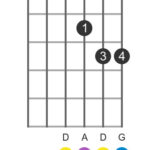The C#7 guitar chord is a fascinating chord that adds a distinctive, somewhat edgy flavor to your guitar playing. It’s not as common as your basic major or minor chords, but learning the C#7 opens up a world of richer sounds and musical possibilities. This chord, often described as bright yet heavy, carries a sense of urgency and intrigue. Let’s dive into how to play the C 7 Guitar Chord and explore why it’s a valuable addition to your chord vocabulary.
What Makes the C#7 Chord Special?
The C#7 chord stands out due to its unique construction. It’s a dominant seventh chord built on the root note C#. The “7” signifies the addition of the 7th degree of the C# major scale, which in this case is B (natural). However, what truly defines the C#7 are the three sharp notes it contains: C#, E#, and G#. This combination creates a sound that’s both bright and dissonant, perfect for adding tension and release in various musical styles. Whether strummed fully or played as an arpeggio, the C#7 chord commands attention.
Two Ways to Play the C#7 Guitar Chord
While some chords have numerous variations, the C#7 is typically played in two primary positions on the guitar. Let’s explore both the most common four-string voicing and the fuller-sounding barre chord version.
Version 1: The Four-String C#7 Chord
This is the most frequently taught and played version of the C#7 chord. It’s relatively easy to grasp and provides a solid, recognizable C#7 sound without using all six strings.
- Finger Placement:
- Index finger: 2nd fret of the B string
- Middle finger: 3rd fret of the D string
- Ring finger: 4th fret of the A string
- Pinky finger: 4th fret of the G string
- Strumming: Strum only the A, D, G, and B strings (strings 5, 4, 3, and 2). Avoid the low E and high E strings.
This voicing is excellent for rhythm guitar parts and when you want a clear, focused C#7 sound without too much bass.
Version 2: The Barre C#7 Chord
For a richer, more powerful C#7 sound, especially in lead guitar or situations where you need a fuller harmonic presence, the barre chord version is ideal. This voicing utilizes five strings and sits higher up the neck.
- Finger Placement:
- Barre index finger across the 4th fret, covering the A, D, G, B, and high E strings.
- Ring finger: 6th fret of the D string
- Pinky finger: 6th fret of the B string
- Strumming: Strum from the A string down to the high E string (strings 5, 4, 3, 2, and 1). Omit the low E string.
The barre C#7 chord offers a more substantial sound and is particularly useful in genres like blues, rock, and jazz where a stronger chord presence is desired.
Understanding the Notes in a C#7 Chord
Whether you play the four-string or barre version, the C#7 chord is always composed of the same four notes:
- Root: C#
- Major Third: E# (enharmonically F natural)
- Perfect Fifth: G#
- Minor Seventh: B
These notes create the characteristic dominant 7th sound, which is often used to create tension and resolution in music. The presence of the major third (E#) and minor seventh (B) intervals in relation to the root (C#) gives the C#7 its bright yet slightly dissonant quality.
Songs That Feature the C#7 Chord
While not as ubiquitous as some other chords, the C#7 appears in a diverse range of songs and genres, often used to add a touch of sophistication or surprise.
- “At Last” by Etta James: This classic ballad beautifully employs the C#7 to create a pivotal shift in the song’s emotional landscape. The c 7 guitar chord acts as a musical exclamation point, emphasizing the joyful realization of finding love.
- “Country Club” by Travis Tritt: In this country hit, the C#7 chord adds a distinctive twang and a touch of unexpected sophistication, mirroring the song’s theme of contrasting country living with the perceived refinement of a country club.
Beyond these examples, listen out for the C#7 chord in:
- Jazz standards – dominant 7th chords are foundational in jazz harmony.
- Blues music – for adding a classic bluesy flavor.
- Pop and R&B – to bring in moments of harmonic interest and color.
Incorporating the C#7 Chord into Your Playing
The C#7 chord is a fantastic tool for adding spice and depth to your guitar playing. Don’t shy away from experimenting with it!
- Use it as a passing chord: Try inserting a C#7 between chords in a progression to create movement and harmonic interest.
- Explore different genres: Experiment with C#7 in blues riffs, jazz chord melodies, or even pop song arrangements.
- Practice transitioning to and from C#7: Smooth chord changes are key. Practice moving between C#7 and chords you already know well.
Conclusion
The C#7 guitar chord, while not a beginner’s first chord, is a rewarding addition to any guitarist’s toolkit. Its unique sound and versatile applications make it a valuable asset for exploring various musical styles. By mastering the two main voicings and understanding its harmonic function, you can unlock new creative possibilities and add a touch of sophistication to your guitar playing. So, take some time to practice the c 7 guitar chord, and you’ll soon find yourself incorporating its distinctive sound into your musical adventures. Explore more chords and expand your musical knowledge further with resources like Fender Play’s chord library.

